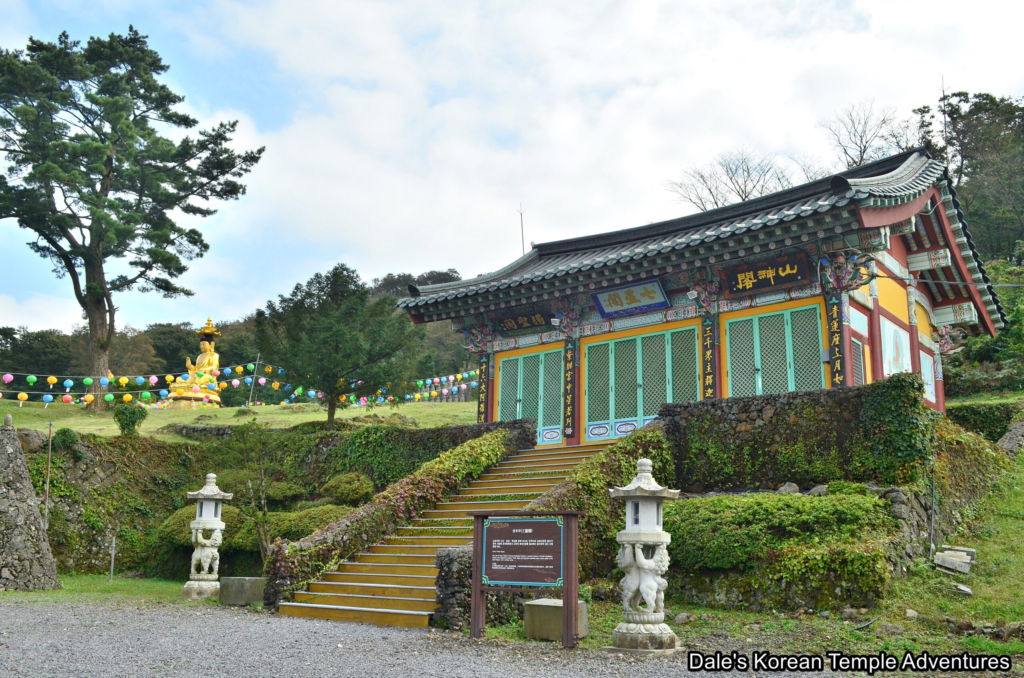
Buddhism and Jeju-do have occupied similarly peripheral and exiled locations in Korean society for centuries. In 1472, King Taejo abolished all Buddhist monasteries and temples, leading to a 400 year period of exile. Buddhists fled to the mountains to create monasteries in inaccessible locations due to Confucian pressure and persecution1. Viewed in parallel, Jeju-do was “known to Koreans as a peripheral place[;] an island of exile, adversity, and hardship”2 because of its history of popular unrest and home of political exiles. Gwaneumsa Temple, the oldest Buddhist Temple on the island3, was originally built during the Goryeo Dynasty and underwent two cycles of destruction and reconstruction4. While the official Korean census does not account for the practitioners of the indigenous religion of Jeju (referred from hereon as shamanism), the majority of the island believes in the efficacy of its practice as of 20165.

Thus, this situates Gwaneumsa Temple as a third place—both for its peripheral location and for its standing as a minority religious space. This marginal position, however, is contrasted by its central geographical and religious location on the island itself. Korean Buddhists, at the time of their exile and onwards, view the mountains of Korea as abodes of various Bodhisattvas and the mountains as sacred Buddhist sites6. Seon Buddhism, the Buddhist denomination of Gwaneumsa Temple, was originally founded in the ninth century by Korean disciples in nine separate mountain locations7. Mt. Hallasan, by extension, is considered a sacred site to many Korean Buddhists. Similarly, many different religious groups consider Mt. Hallasan a sacred location as well: Daoists considered it the home of immortals and stars8 and the general population of Jeju-do revered Mt. Hallasan as the location on which their creation myth occurred9.

Jeju National Museum
Now, we have shown Gwaneumsa Temple to be located at the central nexus of two peripheral communities: Korean Buddhism and the historic Jeju-do population. There exists much overlap between these two groups; most shaman patrons go to Buddhist temples10 and about 23.9% of those who identify as Buddhist on the island participate in shamanistic rituals11. Religion, as an imported category, does not draw as clear distinctions as one may believe. In fact, many Buddhist monks on Jeju-do will perform shamanistic rituals for the general populace—belief in the efficacy of the ritual is the driving motivation for practice rather than a particularly strong and monogamous faith to any one religion12. Korean Buddhism was also seen as a refuge for the disaffected men in the 1600s—many would flee family life and general society in the isolated mountain monasteries of Buddhists13. Gwaneumsa Temple therefore serves and has served two distinct purposes in terms of religion: as a melting pot of various religious practitioners and as a societal refuge.

Furthermore, the temple’s location at the base of Mt. Hallasan demonstrates how it was uniquely able to serve as shelter during what is known as 4.3, or the Jeju-do Popular Uprising. At the end of this brutal conflict, guerillas and those fleeing the massacres used the mountain as a tactical and central base to connect with the island’s villagers14. After the temple was destroyed in this conflict, it was subsequently rebuilt under severe censorship. The particular usage of the temple’s location, both symbolically and physically, exemplifies the duality that all places in the nexus of overlapping margins have. Gwaneumsa Temple may seem isolated because of its place on the spiritual and geographical periphery, but in reality, it has deep ties to everyone in the surrounding community. It serves also as a microcosm of what Jeju Island has become: both central in contemporary Korean history and a place for exiles, conflict that has been rebuilt over and forgotten, and the center of a rapidly changing community that has adapted to blend these contradictory factors together. Gwaneumsa Temple is a third place that has the appearance of being neutral and removed, but whose history reveals instead its centrality in a shifting Korea.
- Starr, Frederick. “Korean Buddhism.” The Journal of Race Development 9, no. 1 (1918): 71–84. https://doi.org/10.2307/29738270. ↩︎
- Park, Myung-Lim. “Towards a Universal Model of Reconciliation: The Case of the Jeju 4.3 Incident.” Journal of Korean Religions 9, no. 1 (2018): 105–30. https://www.jstor.org/stable/26594683. ↩︎
- Hyde, Colleen. “Hidden in the Mountain – Jeju Weekly.” The Jeju Weekly, October 15, 2009. http://www.jejuweekly.com/news/articleView.html?idxno=327. ↩︎
- “자동등록방지를 위해 보안절차를 거치고 있습니다.” jejugwaneumsa.or.kr. Accessed February 23, 2024. http://www.jejugwaneumsa.or.kr/. ↩︎
- Yoo, Yohan. 2020. “Similar but Superior: Rhetoric of Coexistence Employed by Religions in Jeju Island, Korea” Religions 11, no. 4: 198. https://doi.org/10.3390/rel11040198 ↩︎
- Lee, Kyungsoon, and Se-Woong Koo. “The Confucian Transformation of Mountain Space: Travels by Late-Chosŏn Confucian Scholars and the Attempted Confucianization of Mountains.” Journal of Korean Religions 5, no. 2 (2014): 119–43. http://www.jstor.org/stable/24329487. ↩︎
- Pihl, Marshall R. “Koryŏ Sŏn Buddhism and Korean Literature.” Korean Studies 19 (1995): 62–82. http://www.jstor.org/stable/23719140. ↩︎
- Kim, Seongmyeong, Aeryung Lee, and Yeonsook Oh. “Hallasan Mountain – Google Arts & Culture.” Google Arts & Culture. Accessed February 23, 2024. https://artsandculture.google.com/story/hallasan-mountain-jeju-national-museum/KAUxQ_ajwQsA8A?hl=en. ↩︎
- Alawi, Hayla. “Jeju Island, the Three Clans Myth, and Women Divers: Female Importance in Jeju’s Cultural History.” University of Michigan Library – Deep Blue Documents, June 7, 2020. https://deepblue.lib.umich.edu/handle/2027.42/156011. ↩︎
- Yun, Kyoim. “Spiritual Entrepreneurship: Negotiating the Ritual Marketplace on Contemporary Cheju Island, South Korea.” Journal of Ritual Studies 30, no. 2 (2016): 53–65. http://www.jstor.org/stable/44735511. ↩︎
- Yoo, Yohan. 2020. “Similar but Superior: Rhetoric of Coexistence Employed by Religions in Jeju Island, Korea” Religions 11, no. 4: 198. https://doi.org/10.3390/rel11040198 ↩︎
- Yoo, Yohan. 2020. “Similar but Superior: Rhetoric of Coexistence Employed by Religions in Jeju Island, Korea” Religions 11, no. 4: 198. https://doi.org/10.3390/rel11040198 ↩︎
- Starr, Frederick. “Korean Buddhism.” The Journal of Race Development 9, no. 1 (1918): 71–84. https://doi.org/10.2307/29738270. ↩︎
- MERRILL, JOHN. “The Cheju-Do Rebellion.” The Journal of Korean Studies 2 (1980): 139–97. http://www.jstor.org/stable/41490155. ↩︎